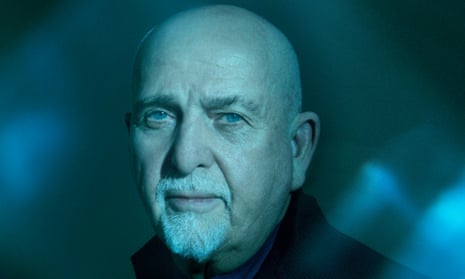Peter Gabriel’s tenth studio album of original material has been compared to both the Beach Boys’ Smile and Guns N’ Roses’ Chinese Democracy. These were two records with legendarily elephantine gestation periods, although the latter seems an inadequate yardstick: Chinese Democracy came out 15 years after Guns N’ Roses’ previous album, a veritable rush release compared to the 28 years Gabriel has been working on i/o.

Its production apparently began concurrently with that of his last album of original material Up, in 1995 – before 70% of the artists in the current UK singles Top 10 were even born. It was first scheduled for release in 2004, two years after Up came out, although you could hardly accuse Gabriel of slacking in the interim period: he’s released nine albums – collections of cover versions and his own songs re-recorded with an orchestra, a film soundtrack, the collaborative work Big Blue Ball (also begun in 1995), three live albums and two compilations – toured seven times, co-founded and sold a digital distribution network, helped launch the international non-governmental organisation the Elders, the “brain-on-music entertainment, media and tech studio” Reverberation and Panopticom. The latter is an “infinitely expandable, universally accessible data globe” for which i/o’s opening track of the same name acts as a kind of jingle, albeit a luxuriously-appointed one: it lasts more than five minutes, comes, like the rest of i/o in two distinct mixes (one by Mark “Spike” Stent and one by Tchad Blake) and features both Brian Eno on synth and session musician supremo Tony Levin on bass.
Moreover, the album has clearly warped and changed dramatically over time. It frequently reads like an extended meditation on old age, a subject a septuagenarian artist has every right to discuss. It variously sees Gabriel haunted by the passing of a previous generation on And Still; aware of his own encroaching mortality – trapped in a body that “stiffens, tires and aches in its wrinkled, blotchy skin” – on So Much; happy to let “the young move to the centre” on Playing for Time and at peace with his place in the cosmic structure of things on the title track. Even when its lyrics venture into current events – Four Kinds of Horses could be aimed at violent religious fundamentalism or rightwing populism and The Court explores the effect of the internet on public discourse – they do so from the vantage point of someone who’s been around a long time: “Ah, you say you’re something different, but you do it all again”, as the former puts it wearily. It’s an approach that’s effective and affecting, but i/o couldn’t have started out like that, for the simple reason that Peter Gabriel was only 45 when he began work on it.
Patched together from sessions in Britain, Italy, South Africa, Sweden and onstage at Rexall Place, a Canadian arena venue that closed down five years ago, it’s to i/o’s immense credit that doesn’t feel like an album that’s been endlessly, if intermittently, reworked over decades. It’s all clearly carefully considered, but it still sounds remarkably fresh as it touches, lightly, on a variety of Gabriel’s longstanding preoccupations. On the tour that accompanied the gradual release of i/o’s tracks online – one every full moon – Gabriel performed his new material alongside the big hits from 1986’s So. If there’s nothing here as obviously commercial as Sledgehammer or Don’t Give Up, there’s definitely a hint of 80s brashness about the horns on the bright-hued Olive Tree and an epic, stadium-ready grandeur to the title track. His interest in music from beyond the west is reflected in the sinuous rhythm of This Is Home. You would struggle to describe And Still as prog rock per se, but its piano, flute and cello certainly trades in the kind of rain-spattered, very English melancholy that was among early 70s Genesis’s key modes.
after newsletter promotion
It’s dense and rewarding and has more interesting things to say than the earnest but pat song titles – Live and Let Live, Love Can Heal – suggest. Anyone wondering at the wisdom of releasing an album consisting of songs already freely available to stream might note that, lunar-influenced drip-fed release or not, it’s clearly been conceived as an album: listened to in one sitting, it ebbs and flows beautifully. And given the size of the gap that separates i/o from Up, it’s tempting to wonder something else: whether it might be Gabriel’s last album of original material. Its highlight might be Playing for Time, a ballad that slowly moves to a dramatic climax. The lyrics feature Gabriel climbing a hill, as the lyrics of his debut solo single did, but this time lost in memories and the thought of time’s passing. It would work perfectly as a grand finale. i/o is so rich in ideas, you hope it won’t have to.
This week Alexis listened to
Ghost Woman – Yoko
Raw power: slashing guitars over a Cramps-by-way-of-Krautrock riff, an impressively chaotic burst of arhythmic noise in lieu of a middle eight.

Comments (…)
Sign in or create your Guardian account to join the discussion